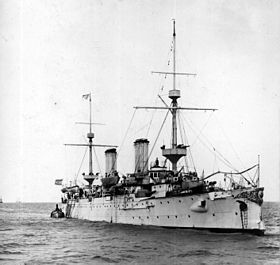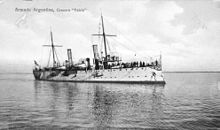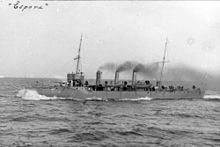Buenos Aires (ship, 1895)
|
|
|
|---|---|
 The Buenos Aires |
|
| Overview | |
| Type | Protected cruiser |
| Shipyard |
Armstrong, Mitchell & Co , Elswick , construction no. 612 |
| Keel laying | February 1893 |
| Launch | May 10, 1895 |
| delivery | November 1895 |
| Namesake | the Argentine capital Buenos Aires |
| Decommissioning | May 17, 1932 |
| Technical specifications | |
| displacement |
4,620 ts, |
| length |
129.2 m over everything, |
| width |
14.16 m |
| Draft |
5.8 m |
| crew |
400 - 429 men |
| drive |
8 cylinder boilers , |
| speed |
23.2 kn |
| Range |
5437 nm at 10 kn |
| Armament |
2 × 203 mm L / 45 Armstrong cannons |
| Coal supply |
300 ts, max. 983 ts |
| Armored deck |
13 to 127 mm |
| Gun shields |
114 mm |
| Command tower |
152 mm |
| very similar | |
The protected cruiser ARA Buenos Aires of the Argentine Navy was the third cruiser, which this at Co Armstrong, Mitchell & acquired. With three new cruisers until 1896, Argentina was one of the strongest users of the so-called Elswick cruiser , before it primarily turned to the procurement of armored cruisers of the Garibaldi class from Italian production. The Buenos Aires reverted to a single heavy bow and stern gun, had four 152 mm rapid fire guns, as the end guns of the side batteries, which could also be used for the bow and stern fire, and between the 152 mm guns on the Three 120 mm rapid-fire guns on each side. She was the largest of the so-called Elswick cruisers and remained in service with the Argentine Navy until 1932.
Building history
Hull number 612, later Buenos Aires , was started as a speculation ship after a decision by the company management in February 1892 after the sale of the Blanco Enclada to Chile in order to keep the skilled workers busy. On November 27, 1892, the ship under construction was sold to Argentina for £ 383,000. She had a steel hull that was optimized for use in the tropics with teak and copper fittings. On May 10, 1895, the "Buenos Aires" was christened by the wife of Commodore D. Martín Rivadavia , who had already been in command of the previous Argentine Elswick cruisers Veinticinco de Mayo and Nueve de Julio and who was currently in charge of the Argentine construction supervision in Europe, which also made the first purchases of armored cruisers in Italy.
With a length of 129.2 m, the new cruiser was considerably larger than its predecessor, and also had two funnels and two masts with combat marshes. The freeboard was considerably higher than either of the first two cruisers. Its two four-cylinder steam engines delivered 14,000 hp with natural pull and enabled 23.2 kn over twelve hours in the acceptance tests. It was not tested whether the cruiser actually produced 17,000 hp when pulled under artificial pull. The heavy load on the boilers from this process largely precluded frequent use by the South American navies, as they did not have the appropriate repair facilities. The boiler equipment consisted of four double-ended and four single cylinder boilers.
In terms of armament, the Buenos Aires had very strong armouring with more modern guns than the two forerunners. She again had a heavy bow and stern gun with two 203 mm, 8-inch L / 45 cannons of the Armstrong type , which were electrically aimed. There were also four 152 mm 6-inch L / 45 Armstrong rapid-fire guns as the end guns of the side batteries, which could also be used for the bow and stern fire and three 120 mm guns on each side between the 152 mm guns. 4.7-inch L / 45 mm Armstrong rapid-fire guns. Sixteen 47 mm and six 37 mm Hotchkiss rapid-fire cannons , which Armstrong manufactured under license, were distributed on the upper deck and installed in the combat marshes of the two masts. The armament was supplemented by five torpedo tubes, which were installed over water in the bow and on the sides. The Buenos Aires had a domed armored deck 13 mm thick and up to 127 mm thick over the machines.
The acceptance tests took place in November 1895. Due to financial difficulties, the transfer of the Buenos Aires to Argentina did not take place until the following spring.
Mission history
In mid-March 1896 the Buenos Aires left England for Buenos Aires, where it arrived on April 29, 1896. In June 1896 she moved as part of the 1st Division of the operational squadron south to the Golfo Nuevo near Puerto Madryn, where she joined the cruisers Veinticinco de Mayo , Nueve de Julio , the armored ship Almirante Brown , the coastal armored ship Libertad and the light cruiser Patria met. In 1897, Buenos Aires formed the first division of the fleet together with the cruisers Nueve de Julio and Veinticinco de Mayo and the torpedo boat destroyer Espora and the transporter Pampa . She carried out survey work on the coast of Chubut and the Río Santa Cruz . In August she returned to Bahía Blanca . Similar tasks followed in 1898. During maneuvers, the Buenos Aires circumnavigated Cape Horn for the first time . In August 1899 she visited Rio de Janeiro with the President of the Republic, Julio Argentino Roca . This was followed by trips to the south of Argentina and hydrographic tasks such as surveying the estuary of the Río Chubut , which was completed.
In 1900 the places for future lighthouses in Chubut , Isla Penguin and the mouth of the Río Santa Cruz were determined. In September maneuvers with the cruisers Nueve de Julio and Veinticinco de Mayo and other hydrographic tasks followed. In 1901, the Buenos Aires participated in maneuvers off Bahía Blanca. She then brings the President of Argentina, General Julio Roca from Puerto Belgrano to Buenos Aires at a speed of 21 knots. In 1902 the fleet maneuvers took place from February to May between Puerto Belgrano and the Río de La Plata. Then the crew of the Buenos Aires was reduced for the first time . In January 1903 she came back into service for the training division, which also included the cruisers Nueve de Julio , Veinticinco de Mayo and, as a reserve, the Patagonia . The training was mainly carried out in front of the Río de La Plata. In 1904 the cruiser was mainly repaired. On October 9, the Argentine President watched from the cruiser the parade of 24 mobilized torpedo boats passing at 18 knots and a competition of rowing boats of the fleet. In 1905 the cruiser remained mostly inactive at La Plata.
In April 1906, Buenos Aires made a trip to Europe, where its artillery was being overhauled in England. The journey passed through Brazilian ports, including Rio de Janeiro. On August 15th, she returned to Buenos Aires. In 1907 she was reassigned to the training division from the end of April, which in addition to her consisted of the armored cruisers San Martin and General Belgrano . In 1908 she carried out maneuvers in the south with the 2nd division of the fleet until June 10th. The division also includes the cruisers Nueve de Julio , Veinticinco de Mayo and Patria , the Pampa as supply and the Azopardo as reconnaissance. After the maneuver, the Buenos Aires served as a training ship for conscripts. In 1909 she was assigned to the 1st Division from April to June and carried out a mock attack on Bahía Blanca during their maneuvers. In 1910 she was involved in the naval maneuvers in southern Argentina from mid-February, and then also took part in the international naval show on the occasion of the 100th anniversary of the founding of Argentina. The Argentine President and the Spanish Princess Isabella von Bourbon took on the naval parade on the Buenos Aires . At the end of July, accompanied by the Patria , she visited with President Dr. Roque Sáenz Peña Rio de Janeiro, where she traveled again in November. This was followed by another trip with the President on board to Ushuaia and back.
In 1911 the cruiser was equipped with a radio system and made another trip to Ushuaia in January. In June he was sent to Spithead to attend the celebrations for George V's accession to the throne . Over 180 ships were present at this fleet parade and 17 foreign countries were represented. The guests also included other Elswick cruisers such as the sister ship Haiqi of the Chinese Navy, the last Elswick cruiser Hamidiye of the Turkish Navy and the last cruiser started as a speculative construction by the shipyard, the Chacabuco of the Chilean Navy. Then visited the Buenos Aires yet Boulogne-sur-Mer , where the Argentine independence fighter Jose de San Martin died in 1850, and on August 25 Montevideo to Uruguay's National Day. Between January and April 1912 the cruiser was overhauled in the Argentine capital and visited Montevideo that year and Rio de Janeiro in November. If necessary, it was the President's yacht and the flagship of the training association, which also included the two cruisers Nueve de Julio and Venticinco de Mayo and the river gunboat Paraná , which mostly remained in the waters of the Río de La Plata. With the Minister of Agriculture, Buenos Aires traveled to Comodoro Rivadavia in 1912 .
On February 3, 1913, on the occasion of the centenary of the Battle of San Lorenzo , the only battle that José de San Martín won on Argentine soil, the President visited Buenos Aires on the Río Paraná . This was followed by another trip with the President to Montevideo in May, another trip with the Minister of Agriculture to Comodoro Rivadavia in August and a trip to Rio de Janeiro in November for Brazil's national holiday.
In 1914 the Buenos Aires was a ship for special tasks and no longer of the training division. She also visited Montevideo (August 25th) and Rio de Janeiro (September 7th) for the national holidays there. Because of the outbreak of the First World War , she made two trips south to Chubut and Comodoro Rivadavia to check compliance with Argentine neutrality. At the beginning of 1915 another cruise followed to the south to monitor the Argentine waters. In March, May and August there were also visits to Montevideo.
In 1916 the Buenos Aires was relocated to Puerto Belgrano as the new home port and only visited with the fleet in July on the occasion of the centenary. In December 1916, a battalion of the Argentine army transported them to Río Gallegos to suppress a strike and uprising there. In 1917 the cruiser was decommissioned in Buenos Aires, was only serviced until 1921 and remained in the reserves.
In 1922 the cruiser Buenos Aires was operational again, was stationed in Puerto Belgrano and regularly visited Rio de Janeiro and the capital Buenos Aires. In 1924 he traveled with members of the government to Comodoro Rivadavia and various ports of Patagonia. At the end of the year he took over training tasks again, which were mainly carried out in southern Argentina. She was in Bahía Blanca in August / September 1925 when the Prince of Wales visited Argentina with the Repulse , Curlew and other units of the Royal Navy .
On February 15, 1926, Buenos Aires began a trip to Spain to bring the crew of the Dornier Whale “Plus Ultra” under Ramón Franco back home after their Atlantic flight. Via São Vicente (Cape Verde) , Las Palmas de Gran Canaria , Huelva (April 5th) she reached the Guadalquivir and opened with the Atlantic pilots and the Spanish King Alfonso XIII. the Alfonso XIII Canal to Seville . On April 6th, the cruiser moved to Cádiz and on the 19th to Cartagena . The return journey took place via Tenerife and Bahia by May 21st to Buenos Aires. This was followed by the traditional visits to Montevideo and Rio de Janeiro and deployment trips to southern Argentina. The ship's new home port was Mar del Plata . Similar voyages followed in 1927 and after an overhaul, the cruiser was assigned as the flagship of the newly formed reconnaissance division in 1928, and unit exercises with the destroyers Cervantes , Garay Cordoba and Catamarca took place. At the end of the year, the Buenos Aires visited Rio de Janeiro and on December 16 with President Dr. Hipólito Yrigoyen Montevideo.
In April 1929 she made her last major trip abroad to Cuba and visited Havana under Admiral Juan A. Martín . The return trip was carried out at an average speed of 14 knots. On June 27, the cruiser was decommissioned, but came back into service in Buenos Aires in December, before moving to southern Argentina in early 1930. The army's coup on September 6th put an end to attempts to create a naval dominated region there and Buenos Aires returned to La Plata in late September. There she became the flagship of the fleet's training units and worked with the school boats M-3 , M-5 and M-8 .
Final fate of Buenos Aires
On May 17, 1932, the Buenos Aires was removed from the fleet list and sold for demolition in 1935.
Sister ships
The Argentine Buenos Aires had two sister ships with the Chinese cruisers Haiqi and Haitien . These had no steel hull clad for tropical service and no 152-mm-6-inch guns, but a single battery of ten 120-mm-L / 45-Armstrong rapid-fire guns.
Hai Tien was lost in an accident near Shanghai in 1904 . Hai Chi remained in service until the Sino-Japanese War in 1937 and was then sunk as a block ship in the Yangtze without much success .
Other ships of the Navy named Buenos Aires
The next Buenos Aires was a destroyer similar to the British G- Class , which was launched on September 21, 1937 at Vickers Armstrong in Barrow-in-Furness and on April 4, 1938, entered service with the Argentine Navy . She stayed in service until 1971.
literature
- Peter Brooke: Warships for Export: Armstrong Warships 1867-1927. World Ship Society, Gravesend 1999, ISBN 0-905617-89-4
- Roger Chesneau, Eugène M. Koleśnik, NJM Campbell: Conway's All the World's Fighting Ships, 1860-1905. Naval Institute Press, Annapolis, Md. 1979, ISBN 0-85177-133-5 .
- John Evelyn Moore: Jane's Fighting Ships of World War I. Military Press, New York 1990.
Web links
Footnotes
- ↑ Brook, p. 82
- ↑ Ironclad Almirante Brown , 1880 Samuda Brothers , 4300 ts, 14 kn
- ^ Coastal armored ship Libertad , 1890 Laird , 2336 ts, 11 kn
- ↑ Torpedo cannon boat Patria , 1893 Laird, 1070 ts, 20.5 knots, similar to British Dryad class, replacement of the sunken Rosales
- ↑ Torpedo boat destroyer Espora , 1889 Laird, 590 ts, 19.5 kn
- ^ Transporter Pampa ex Cadiz , 1895 Connell (Glasgow), 119 m long, 8700 t, 14 kn
- ↑ Cruiser Patagonia , 1885 ST Trieste , 1442 ts, 14 kn
- ↑ Tug Azopardo , 1885 ST Trieste, 43.5 m long, 383 t, 12 kn
- ↑ Paraná , 1908 Armstrong Whitworth, 1060 t, two 152 mm L / 13 howitzers, six 76 mm L / 50 rapid fire guns, 15 kn
- ↑ Cervantes , Garay , destroyers bought from Spain in 1927, 1522 tons, 37kn
- ↑ Destroyer Cordoba , 1912 Schichau, 1000 t, 32 kn
- ↑ Destroyer Catamarca , 1912 Germania, 997 t, 32 kn
- ↑ in Germany in 1923 (total. 10) acquired minesweepers from Type 1916




